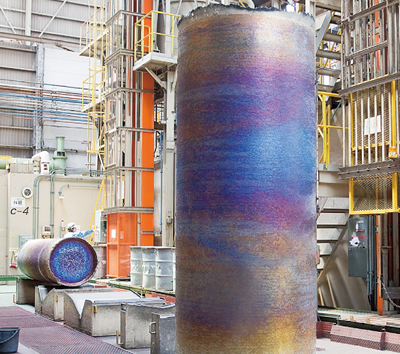Titanium ingots

Pure titanium or titanium alloy ingots are made by melting titanium sponge, with the addition of the alloying
elements in the case of titanium alloys. Since titanium reacts readily with oxygen, nitrogen and carbon, the
melting process is performed in a vacuum or inert atmosphere.
Water-cooled copper is used for the crucible.
Methods that can be used to melt the titanium include consumable electrode vacuum arc, electron beam, and
plasma arc. We use the consumable electrode vacuum arc method, the method most widely utilized on an
industrial basis.
Titanium ingot manufacturing process【first melt】
The manufacture of titanium ingots starts by forming the titanium sponge and titanium scrap into compacts using a press. These are joined together by plasma arc welding to make the consumable electrode, which goes through an arc melting in a vacuum or inert atmosphere to become the first melt ingot. (The melting process starts with an arc forming between the electrode and the crucible. As the electrode melts, the metal runs down and is cooled in the crucible below, forming the first melt ingot.)
Titanium ingot manufacturing process【second melt】
To ensure even quality, the first melt ingots are used as electrodes and remelted. After quality control checks, the second melt ingots produced are shipped as final products.
Properties of titanium ingot
We manufacture pure titanium ingots with excellent surface condition and high internal quality, in large sizes (5 to 10 tons) with composition appropriate for specific requirements. The uses of pure titanium include heat exchangers and piping for petrochemical plants, thermal/nuclear power plants, and sea water desalination plants.
